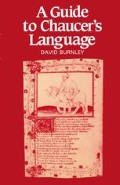Abstract
Language is an abstraction which we encounter in two distinct physical realisations: that is, either as a string of spoken sounds, or as a sequence of marks upon a page. Although we rarely stop to consider whether these two are identical reflections of each other,1 there are few of us who would write an expression like ‘When he saw us, he went: “Oh no!”’ unless we were deliberately imitating speech.2 Evidently, therefore, there is a distinction between written and spoken language on the level of phraseology at least. Furthermore, we have seen in the last chapter how ambiguity in the scope of negation occurs in written language, but might have been clarified by stress in the spoken language of the day. There are, indeed, important differences both in the forms and working of the two realisations of language.
Preview
Unable to display preview. Download preview PDF.
Notes
W. Haas, Phono-graphic Translation (Manchester: Manchester U.P., 1970) pp. 7–16.
A. Martinet, ‘Le Mot’ in Problèmes du Langage (Paris: Gallimard, 1966) pp. 39–53;
R. H. Robins, General Linguistics: an Introductory Survey, 3rd edn (London: Longmans, 1980) pp. 148–54
S. Ullmann, Semantics: An Introduction to the Science of Meaning (Blackwell: Oxford, 1969) pp. 26–53. This last contains a useful bibliography on the question of the linguistic definition of the unit word.
A more recent and accessible statement is that by Margaret Berry, Introduction to Systemic Linguistics, 2 vols (London: Batsford, 1975–7).
On the reputation of alliterative style as battle poetry, see G. Shepherd, ‘The Nature of Alliterative Poetry in Late Medieval England’, PBA, LVI (1970) 57–76.
Also T. Turville-Petre, The Alliterative Revival (Cambridge: D. S. Brewer, 1977) pp. 100–101.
R. Quirk has pointed out the way in which alliterative metrical connections carry with them semantic and lexical presuppositions in ‘Poetic Language and Old English Metre’, in Arthur Brown and Peter Foote (eds), Early English and Norse Studies presented to Hugh Smith (London: Methuen, 1963) pp. 150–71; reprinted in R. Quirk, Essays on the English Language Medieval and Modern (London: Longman, 1968) pp. 1–19.
On the relationship between meaning and collocation, see also J. McH. Sinclair, ‘Beginning the Study of Lexis’, in Bazell, Catford, Halliday and Robins (eds), In Memory of J. R. Firth (London: Longman, 1966).
Ruth Finnegan points out that repeated patterns and parallelisms are found in all poetic composition. Nevertheless such devices are perhaps especially prominent in oral poetry. See her discussion of style and performance in oral poetry: R. Finnegan, Oral Poetry: its Nature, Significance and Social Context (Cambridge U.P., 1977) pp. 88–133.
On the use of doublets, see I. Koskenniemi, Repetitive Word Pairs in Old and Early Middle English Prose, Annales Universitatis Turknensis, Ser. B, Tom. 107 (Turku, 1968).
W. O. Ross (ed.), Middle English Sermons from MS Royal 18B xxiii, EETS OS 209 (London, 1938) pp. 175, 180, 217, 235 etc. The phrase ‘here may ye see’ is a common introduction to the moralizatio of the exemplum.
Copyright information
© 1983 David Burnley
About this chapter
Cite this chapter
Burnley, D. (1983). Textual Coherence. In: A Guide to Chaucer’s Language. Palgrave, London. https://doi.org/10.1007/978-1-349-86048-7_4
Download citation
DOI: https://doi.org/10.1007/978-1-349-86048-7_4
Publisher Name: Palgrave, London
Print ISBN: 978-0-333-33532-1
Online ISBN: 978-1-349-86048-7
eBook Packages: Palgrave Literature & Performing Arts CollectionLiterature, Cultural and Media Studies (R0)

